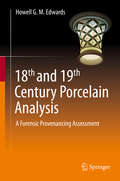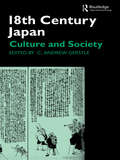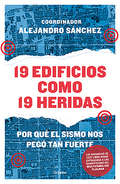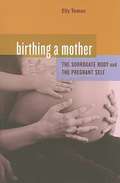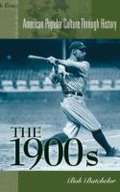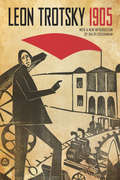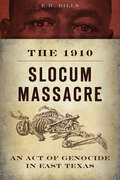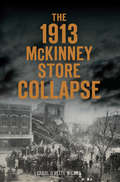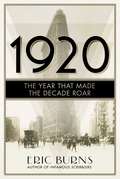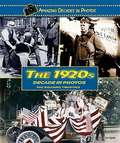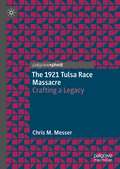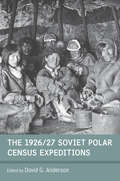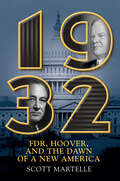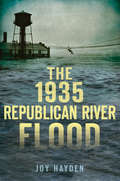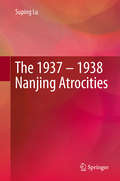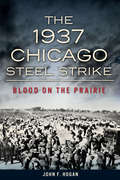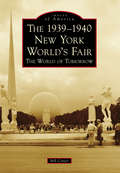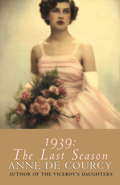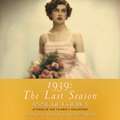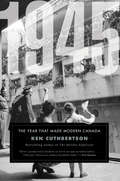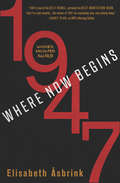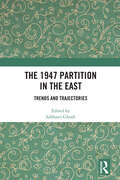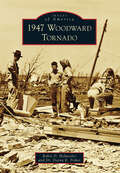- Table View
- List View
18th and 19th Century Porcelain Analysis: A Forensic Provenancing Assessment
by Howell G. EdwardsThis book addresses the contributions made by analytical chemistry to the characterisation of 18th and early 19th Century English and Welsh porcelains commencing with the earliest reports of Sir Arthur Church and of Herbert Eccles and Bernard Rackham using chemical digestion techniques and concluding with the most recent instrumental experiments, which together span more than a hundred years of study. From the earliest experiments which required necessarily the sacrifice of significant portions of each specimen, which may already have been damaged , to the latest experiments which needed only microsampling or the non-destructive interrogation of valuable perfect specimens a comprehensive survey is undertaken of more than twenty manufactories of quality porcelains. The correlation is made between the quantitative elemental oxide determinations of the scanning electron microscopic diffraction and Xray fluorescence data and the qualitative molecular spectroscopic Raman data to demonstrate their complementarity and use in the holistic forensic assessment of the origin of the fired procelains ; this will form the groundwork for the adoption of analytical techniques for the attribution of unknown or questionable procelains to their potential source factories . The book will also examine the perception of what constitutes a porcelain and its definitions and examines the assignment of porcelains to types which currently employs the definitions of hard paste , soft paste , hybrid , magnesian and bone china from the conclusions derived from the analytical data and a consideration of the raw materials employed in their manufacturing processes. During the discussion of this analytical evidence several themes and protocols have been established for its utilisation in the potential identification of porcelains and several case studies undertaken for this purpose are cited. The book will be of interest to analytical scientists , to museum ceramics curators and to ceramics historians.
18th Century Japan: Culture and Society
by C. Andrew GerstleThe period of Japanese history before the advent of industrialisation and modernism is of tremendous interest. The essays in this collection show a fascination with the social context behind the development of aesthetics, drama, language, art and philosophy, whether it be the world of the pleasure quarters or the Shogun's court.
19 edificios como 19 heridas: Por qué el sismo nos pegó tan fuerte
by Alejandro SánchezEl 19 de septiembre de 2017 un terremoto azotó México. Murieron 369 personas. Pero no las mató el sismo. Los responsables fueron la corrupción, la impunidad, la dejadez, el olvido e incluso la falta de cultura cívica. A un año del desastre, esta obra investiga qué salió mal en 19 de los edificios más dañados por el temblor. ¿Por qué hubo tantos muertos 32 años después del terremoto de 1985? El libro, así, pinta cuáles son los problemas que resquebrajaron México... y alerta: si no se solucionan, volverá a ocurrir una tragedia similar. Reportajes de: Óscar Alarcón - Hugo Corzo Zanabria - Silvia Garduño Francisco Goldman - Édgar Ledesma Gasca - Albinson Linares Francisco Nieto - Ernesto Núñez Albarrán - Georgina Olson Jiménez Peniley Ramírez - Paris Alejandro Salazar - Nantzin Saldaña Neldy San Martín # Alejandro Sánchez - Laura Sánchez Ley Claudia Solera - Laura Toribio - Daniel Venegas. Las ganancias de este libro serán entregadas a los damnificados del Multifamiliar Tlalpan.
19 Steps Up the Mountain
by Joseph P. BlankIt is the story of Dorothy and Bob DeBolt, who could not resist the appeal of children no one else wanted. Children of different races and nationalities, children with seemingly hopeless physical handicaps and bleak futures. It is the story of the children themselves, each learning what it meant to be loved, and what it was to overcome the most heart rending obstacles. Two parents. Nineteen children. And the single most unforgettable story that will ever leave you with mist in your eyes and joy in your heart. "A tonic for cynical and disheartened readers...This book tells clearly what it takes to be successful parents, especially when J.R.-a blind paraplegic-conquers his fear and makes it up the 19-step staircase 'mountain' alone"
The 1900s: (American Popular Culture Through History)
by Bob BatchelorThis is a delightful history of twentieth century culture. Some of the topcis covered: music, dance, fashion, commercials. Informative and fun.
1905
by Leon TrotskyLeon Trotsky's 1905-despite long being out of print-has remained the central point of reference for those looking to understand the rising of workers, peasants, and soldiers that nearly unseated the Tsar in 1905. Trotsky's elegant, beautifully written account draws on his experience as a key leader of the revolution.
The 1910 Slocum Massacre: An Act Of Genocide In East Texas (True Crime)
by E.R. BillsIn late July 1910, a shocking number of African Americans in Texas were slaughtered by white mobs in the Slocum area of Anderson County and the Percilla-Augusta region of neighboring Houston County. The number of dead surpassed the casualties of the Rosewood Massacre in Florida and rivaled those of the Tulsa Riots in Oklahoma, but the incident--one of the largest mass murders of blacks in American history--is now largely forgotten. Investigate the facts behind this harrowing act of genocide in E.R. Bills's compelling inquiry into the Slocum Massacre.
The 1913 McKinney Store Collapse (Disaster)
by Carol O'Keefe WilsonA powerful vibration, a deafening noise and a swell of thick dust brought residents of McKinney pouring into the public square on the afternoon of January 23, 1913. What they saw was horrifying--an entire building had collapsed, demolishing two popular retailers, the Cheeves Mississippi Store and Tingle Implement Store. Their contents, including many shoppers and clerks, spilled out into the streets, where layer upon layer of debris settled into a massive, ragged pile. In spite of a herculean rescue effort, eight people perished. Carol Wilson sifts through the disaster and its aftermath, dredging up some troubling facts about how the tragedy might have been prevented.
1919, The Year of Racial Violence
by David F. Krugler1919, The Year of Racial Violence recounts African Americans' brave stand against a cascade of mob attacks in the United States after World War I. The emerging New Negro identity, which prized unflinching resistance to second-class citizenship, further inspired veterans and their fellow black citizens. In city after city - Washington, DC; Chicago; Charleston; and elsewhere - black men and women took up arms to repel mobs that used lynching, assaults, and other forms of violence to protect white supremacy; yet, authorities blamed blacks for the violence, leading to mass arrests and misleading news coverage. Refusing to yield, African Americans sought accuracy and fairness in the courts of public opinion and the law. This is the first account of this three-front fight - in the streets, in the press, and in the courts - against mob violence during one of the worst years of racial conflict in US history.
1920: The Year that Made the Decade Roar
by Eric BurnsOne of the most dynamic eras in American history--the 1920s--began with this watershed year that would set the tone for the century to follow. "The Roaring Twenties" is the only decade in American history with a widely applied nickname, and our collective fascination with this era continues. But how did this surge of innovation and cultural milestones emerge out of the ashes of The Great War? No one has yet written a book about the decade's beginning. Acclaimed author Eric Burns investigates the year of 1920, which was not only a crucial twelve-month period of its own, but one that foretold the future, foreshadowing the rest of the 20th century and the early years of the 21st, whether it was Sacco and Vanzetti or the stock market crash that brought this era to a close. Burns sets the record straight about this most misunderstood and iconic of periods. Despite being the first full year of armistice, 1920 was not, in fact, a peaceful time--it contained the greatest act of terrorism in American history to date. And while 1920 is thought of as starting a prosperous era, for most people, life had never been more unaffordable. Meanwhile, African Americans were putting their stamp on culture and though people today imagine the frivolous image of the flapper dancing the night away, the truth was that a new kind of power had been bestowed on women, and it had nothing to do with the dance floor. . . From prohibition to immigration, the birth of jazz, the rise of expatriate literature, and the original Ponzi scheme, 1920 was truly a year like no other.
The 1920s Decade in Photos: The Roaring Twenties (Amazing Decades in Photos)
by Jim CorriganMiddle school readers will find out about the important world, national, and cultural developments of the decade 1920-1929.
The 1921 Tulsa Race Massacre: Crafting a Legacy
by Chris M. MesserThis book examines the Tulsa Race Massacre of 1921, perhaps the most lethal and financially devastating instance of collective violence in early twentieth-century America. The Greenwood district, a comparably prosperous black community spanning thirty-five city blocks, was set afire and destroyed by white rioters. This work analyzes the massacre from a sociological perspective, extending an integrative approach to studying its causes, the organizational responses that followed, and the complicated legacy that remains.
The 1926/27 Soviet Polar Census Expeditions
by David G. AndersonIn 1926/27 the Soviet Central Statistical Administration initiated several yearlong expeditions to gather primary data on the whereabouts, economy and living conditions of all rural peoples living in the Arctic and sub-Arctic at the end of the Russian civil war. Due partly to the enthusiasm of local geographers and ethnographers, the Polar Census grew into a massive ethnological exercise, gathering not only basic demographic and economic data on every household but also a rich archive of photographs, maps, kinship charts, narrative transcripts and museum artifacts. To this day, it remains one of the most comprehensive surveys of a rural population anywhere. The contributors to this volume - all noted scholars in their region - have conducted long-term fieldwork with the descendants of the people surveyed in 1926/27. This volume is the culmination of eight years' work with the primary record cards and was supported by a number of national scholarly funding agencies in the UK, Canada and Norway. It is a unique historical, ethnographical analysis and of immense value to scholars familiar with these communities' contemporary cultural dynamics and legacy.
1932: FDR, Hoover, and the Dawn of a New America
by Scott MartelleA fascinating behind-the-scenes look at a year in American history that still resonates today, 1932: FDR, Hoover, and the Dawn of a New America tells the story of a battered nation fighting for its own future amid the depths of the Great Depression. At the start of 1932, the nation&’s worst economic crisis has left one-in-four workers without a job, countless families facing eviction, banks shutting down as desperate depositors withdraw their savings, and growing social and political unrest from urban centers to the traditionally conservative rural heart of the country. Amid this turmoil, a political decision looms that will determine the course of the nation. It is a choice between two men with very diferent visions of America: Incumbent Republican Herbert Hoover with his dogmatic embrace of small government and a largely unfettered free market, and New York&’s Democratic Governor Franklin Delano Roosevelt and his belief that the path out of the economic crisis requires government intervention in the economy and a national sense of shared purpose. Now veteran journalist Scott Martelle provides a gripping narrative retelling of that vitally significant year as social and political systems struggled under the weight of the devastating Dust Bowl, economic woes, rising political protests, and growing demand for the repeal of Prohibition. That November, voters overwhelmingly rejected decades of Republican rule and backed Roosevelt and his promise to redefine the role of the federal government while putting the needs of the people ahead of the wishes of the wealthy. Deftly told, this illuminating work spotlights parallel events from that pivotal year and brings to life figures who made headlines in their time but have been largly forgotten today. Ultimately, it is the story of a nation that, with the help of a leader determined to unite and inspire, took giant steps toward a new America.
The 1935 Republican River Flood (Disaster)
by Joy HaydenOn May 31, 1935, a storm system surged along the Republican River, bursting its banks in a matter of minutes with a roar that could be heard miles away. The greatest flood to hit the tri-state area of Colorado, Kansas and Nebraska, it left behind a landscape rearranged beyond recognition and claimed more than one hundred casualties. However, amid all the destruction and sorrow, amazing acts of heroism and unwavering courage were reported throughout the valley. Author Joy Hayden reveals the historic disaster and the steadfast resolve of those who witnessed it.
The 1937 – 1938 Nanjing Atrocities
by Suping LuThis book presents a comprehensive overview of the Nanjing Massacre, together with an in-depth analysis of various aspects of the event and related issues. Drawing on original source materials collected from various national archives, national libraries, church historical society archives, and university libraries in China, Japan, Germany, United Kingdom and the United States, it represents the first English-language academic attempt to analyze the Nanjing Massacre in such detail and scope.The book examines massacres and other killings, in addition to other war crimes, such as rape, looting, and burning. These atrocities are then explored further via a historical analysis of Chinese survivors’ testimony, Japanese soldiers’ diaries, Westerners’ eyewitness accounts, the news coverage from American and British correspondents, and American, British and German diplomatic dispatches. Further, the book explores issues such as the role and function of the International Committee for Nanking Safety Zone, burial records of massacre victims, post-war military tribunals, controversies over the Nanjing Massacre, and the 100-Man Killing Contest.This book is intended for all researchers, scholars, graduate and undergraduate students, and members of the general public who are interested in Second World War issues, Sino-Japanese conflicts, Sino-Japan relations, war crimes, atrocity and holocaust studies, military tribunals for war crimes, Japanese atrocities in China, and the Nanjing Massacre.
The 1937 Chicago Steel Strike: Blood on the Prairie
by John F. HoganThis in-depth history of the Memorial Day Massacre brings new clarity to the conflicting reports that left too many questions unanswered. A violent period of American labor history reached its bloody apex in 1937 when rattled Chicago police shot, clubbed, and gassed a group of men, women, and children attempting to picket Republic Steel&’s South Chicago plant. Ten died and over one hundred were wounded in what became known as the Memorial Day Massacre. A newsreel camera captured about eight minutes of the confrontation, yet local and congressional investigations amazingly reached opposite conclusions about what happened and why. Now Chicago historian John Hogan sifts through the conflicting reports of all those entangled in that fateful day, including union leaders, news reporters, and an undercover National Guard observer revealed after seventy-six years.
The 1939-1940 New York World's Fair: The World of Tomorrow (Images of America)
by Bill CotterThe World of Tomorrow
1939: The Last Season
by Anne de CourcyA wonderful portrait of British upper-class life in the Season of 1939 - the last before the Second World War.The Season of 1939 brought all those 'in Society' to London. The young debutante daughters of the upper classes were presented to the King and Queen to mark their acceptance into the new adult world of their parents. They sparkled their way through a succession of balls and parties and sporting events.The Season brought together influential people not only from Society but also from Government at the various events of the social calendar. Prime Minister Neville Chamberlain chaperoned his debutante niece to weekend house parties; Lord Halifax, the Foreign Secretary, lunched with the Headmaster of Eton; Cabinet Ministers encountered foreign Ambassadors at balls in the houses of the great hostesses. As the hot summer drew on, the newspapers filled with ever more ominous reports of the relentless progress towards war. There was nothing to do but wait - and dance. The last season of peace was nearly over.
1939: The Last Season
by Anne de CourcyA wonderful portrait of British upper-class life in the Season of 1939 - the last before the Second World War.The Season of 1939 brought all those 'in Society' to London. The young debutante daughters of the upper classes were presented to the King and Queen to mark their acceptance into the new adult world of their parents. They sparkled their way through a succession of balls and parties and sporting events.The Season brought together influential people not only from Society but also from Government at the various events of the social calendar. Prime Minister Neville Chamberlain chaperoned his debutante niece to weekend house parties; Lord Halifax, the Foreign Secretary, lunched with the Headmaster of Eton; Cabinet Ministers encountered foreign Ambassadors at balls in the houses of the great hostesses. As the hot summer drew on, the newspapers filled with ever more ominous reports of the relentless progress towards war. There was nothing to do but wait - and dance. The last season of peace was nearly over.
1939: The Last Season
by Anne de CourcyA wonderful portrait of British upper-class life in the Season of 1939 - the last before the Second World War.The Season of 1939 brought all those 'in Society' to London. The young debutante daughters of the upper classes were presented to the King and Queen to mark their acceptance into the new adult world of their parents. They sparkled their way through a succession of balls and parties and sporting events.The Season brought together influential people not only from Society but also from Government at the various events of the social calendar. Prime Minister Neville Chamberlain chaperoned his debutante niece to weekend house parties; Lord Halifax, the Foreign Secretary, lunched with the Headmaster of Eton; Cabinet Ministers encountered foreign Ambassadors at balls in the houses of the great hostesses. As the hot summer drew on, the newspapers filled with ever more ominous reports of the relentless progress towards war. There was nothing to do but wait - and dance. The last season of peace was nearly over.
1945: The Year That Made Modern Canada
by Ken CuthbertsonIt was a watershed year for Canada and the world. 1945 set Canada on a bold course into the future. A huge sense of relief marked the end of hostilities. Yet there was also fear and uncertainty about the perilous new world that was unfolding in the wake of the American decision to use the atomic bomb to bring the war in the Pacific to a dramatic halt. On the eve of WWII, the Dominion of Canada was a sleepy backwater still struggling to escape the despair of the Great Depression. But the war changed everything. After six long years of conflict, sacrifice and soul-searching, the country emerged onto the world stage as a modern, confident and truly independent nation no longer under the colonial sway of Great Britain. Ken Cuthbertson has written a highly readable narrative that commemorates the seventy-fifth anniversary of the end of WWII and chronicles the events and personalities of a critical year that reshaped Canada. 1945: The Year That Made Modern Canada showcases the stories of people—some celebrated, some ordinary—who left their mark on the nation and helped create the Canada of today. The author profiles an eclectic group of Canadians, including eccentric prime minister Mackenzie King, iconic hockey superstar Rocket Richard, business tycoon E. P. Taylor, Soviet defector Igor Gouzenko, the bandits of the Polka Dot Gang, crusading MP Agnes Macphail, and authors Gabrielle Roy and Hugh MacLennan, among many others. The book also covers topics like the Halifax riots, war brides, the birth of Canada’s beloved social safety net, and the remarkable events that sparked the Cold War. 1945 is the unforgettable story of our nation at the moment of its modern birth.
1947: Where Now Begins
by Fiona Graham Elisabeth ÅsbrinkAn award-winning writer captures a year that defined the modern world, intertwining historical events around the globe with key moments from her personal history.The year 1947 marks a turning point in the twentieth century. Peace with Germany becomes a tool to fortify the West against the threats of the Cold War. The CIA is created, Israel is about to be born, Simone de Beauvoir experiences the love of her life, an ill George Orwell is writing his last book, and Christian Dior creates the hyper-feminine New Look as women are forced out of jobs and back into the home. In the midst of it all, a ten-year-old Hungarian-Jewish boy resides in a refugee camp for children of parents murdered by the Nazis. This year he has to make the decision of a lifetime, one that will determine his own fate and that of his daughter yet to be born, Elisabeth.
The 1947 Partition in The East: Trends and Trajectories
by Subhasri GhoshThis book explores the experiences of people affected by the Partition of British India and princely states in 1947 through first-person accounts, memoirs, archival material, literature, and cinema. It focuses on the displacement, violence and trauma of the people affected and interrogates the interrelationships between nationalism, temporality, religion, and citizenship. The authors examine the mass migrations triggered by the 1947 Partition, amidst nationalist posturing, religious violence, and debates on crucial issues of refugee rehabilitation and redistribution of land and resources. It focuses on the drawing of the borders and the ruptures in the socio-cultural bonds within regions and communities brought on by demographic changes, violence, and displacement. The volume reflects on the significant mark left by the event on the socio-political sensibilities of various communities, and the questions of identity and citizenship. It also studies the effects of Partition on the politics of Bangladesh and India’s east and northeast states, specifically Bengal, Assam and Tripura. A significant addition to the existing corpus on Partition historiography, this book will be of interest to modern Indian history, partition studies, border studies, sociology, refugee and migration studies, cultural studies, literature, post-colonial studies and South Asian studies, particularly those concerned with Bengal, Northeast India and Bangladesh.
1947 Woodward Tornado (Images of America)
by Robin D. Hohweiler Dr. Deena FisherThe 1947 Woodward Tornado remains the deadliest tornado in Oklahoma history, leaving more than 100 people dead and nearly 1,000 seriously injured. The tornado struck the city of Woodward under cover of darkness and without warning at 8:42 p.m. on April 9, 1947. The storm left in its wake hundreds of stories of tragic loss, devastation, and even mysteries that remain unsolved. These include the three unidentified girls--one as young as six months--whose bodies have remained unclaimed, as well as the mystery of what happened to Joan Gay Croft, a girl who disappeared from the local hospital on the night of the storm. Croft's disappearance was featured in an episode of the television show Unsolved Mysteries in the early 1990s. There is also the oft-overlooked story of those who took up residence (some for more than a year) in "Tornado Town" west of the city and found some glimmer of hope in an otherwise hopeless situation.
